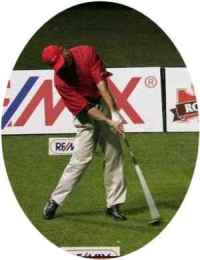
Vijay is one of the hardest workers on the PGA tour and is constant fixture on the practice tee. The native Fijian finished the 1999 PGA season ranked 10th in scoring average and second on the money list. He has even improved since then. Vijay was first on the money list in PGA year 2003. He is one of the best golfers in the world and he continues to improve. He is rated No:2 in the world as of Feb 2004. He now has his sights on Tiger Woods number one status.
Singh's father, Mohan, was an aircraft technician and part-time golf instructor. All three of Mohan's sons -- Vijay, Krishna and Mira -- played golf from the earliest ages but it was Vijay who became possessed by the sport.
"Without my dad starting me out, I would never have been here or learned how to play golf," he said.
As a kid, he never saw a Masters championship on TV, only on video.
"We didn't have live TV," he said. "So I would watch it when the video came in."
They lived on one side of the main runway for the Nandi airport while the golf club was on the other. As an eight-year-old, Vijay would run madly across the grassy airfield in between arrivals and departures to pursue his passion for golf.
 He was 15 when he won his first tournament and at 17 he was playing the Asian Tour. That was where disaster struck, at the age of 22 after years of struggling. Depending upon whose version you believe, it was either a doctored scorecard or he was made a scapegoat for a tour official's error.
He was 15 when he won his first tournament and at 17 he was playing the Asian Tour. That was where disaster struck, at the age of 22 after years of struggling. Depending upon whose version you believe, it was either a doctored scorecard or he was made a scapegoat for a tour official's error.
In any event, he was accused of cheating and banned from tournament golf for two years.
Singh was more or less blacklisted. He could not play and every job he applied for was denied until he caught on at a golf club that may be considered the most remote frontier in golf, the Keningau Club deep in the rain forests of Borneo where American oil workers went for rest and relaxation.
"Although it was a struggle, it was a peaceful struggle," Singh said. "But I'd never swap that for now. This is something that I think you can't beat."
When his exile was over, he went to play in Africa where he regained his confidence and then on to the European Tour where he worked like a demon on his game to achieve his ultimate goal, a place on the PGA Tour in North America.
"I'd always wanted to come over and play in America," he said. "When I came over, I won during the first full season I was here and it made me believe I could win under any conditions on any course."
 That became evident when Singh won the PGA Championship at Valhalla in Louisville Kentucky and was reinforced emphatically at Augusta winning the 2000 Masters.
That became evident when Singh won the PGA Championship at Valhalla in Louisville Kentucky and was reinforced emphatically at Augusta winning the 2000 Masters.
Singh's ascent to the top of his profession is a testament to an incredible work ethic. His obsession with practice is legend on tour.
Singh's idea of a week off from golf is to practice only six hours a day. When he's playing a tournament, he sometimes practises for three hours at both ends of his round.
He has been doing this for 25 years, usually off at one end or the other of the range, beating balls. By now, he must have made, what, a million swings? Two million?
"When I first started out, I copied Tom Weiskopf's swing from videos," he said. "I would look at it on the TV and then go out in the yard and try to duplicate it.
When he took his golf bag out of the trunk of his car during the Masters Tournament, he found a note attached, written in his nine-year-old son Qass Seth's hand. "Trust your swing," it said.
"And that's what I did. I've been preparing for this a long, long time, all over the world."
|




 Click on the Video Camera to view Vijay Singh's golf swing
Click on the Video Camera to view Vijay Singh's golf swing


 He was 15 when he won his first tournament and at 17 he was playing the Asian Tour. That was where disaster struck, at the age of 22 after years of struggling. Depending upon whose version you believe, it was either a doctored scorecard or he was made a scapegoat for a tour official's error.
He was 15 when he won his first tournament and at 17 he was playing the Asian Tour. That was where disaster struck, at the age of 22 after years of struggling. Depending upon whose version you believe, it was either a doctored scorecard or he was made a scapegoat for a tour official's error.  That became evident when Singh won the PGA Championship at Valhalla in Louisville Kentucky and was reinforced emphatically at Augusta winning the 2000 Masters.
That became evident when Singh won the PGA Championship at Valhalla in Louisville Kentucky and was reinforced emphatically at Augusta winning the 2000 Masters.